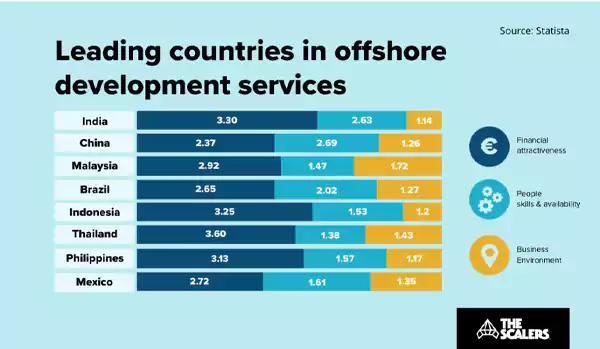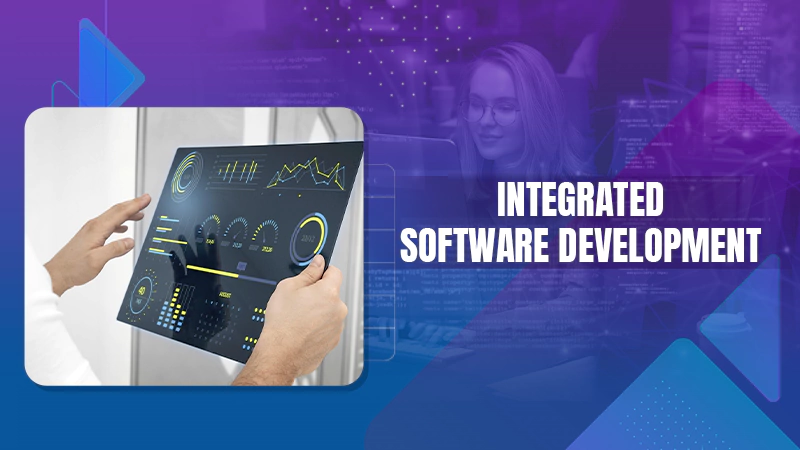How to Ensure Quality in Offshore Software Development
Jump To Key Section
- Setting Clear Objectives and Requirements
- Rigorous Screening and Onboarding
- Following Established Coding Standards
- Implementing Code Reviews and Testing
- Enabling Ongoing Collaboration
- Providing Effective Project Management
- Conducting Security and Compliance Reviews
- Promoting Process Consistency
- Monitoring Progress and Results
- Maintaining Technical Alignment
- Building Strong Relationships and Culture
- Conducting Project Retrospectives
- Final Words
Offshore software development provides alluring benefits like reduced costs, access to specialized talent pools, and the ability to accelerate projects with round-the-clock teams.
However, organizations must implement rigorous quality assurance practices to fully realize the advantages of distributed software engineering.
Major hazards around miscommunications, security, skill mismatches, and lack of alignment can manifest without proper oversight and collaboration rituals.
This comprehensive guide will outline the key factors and processes required to deliver high-quality results through overseas development partnerships.
We will cover:
- Setting Clear Objectives and Requirements
- Rigorous Screening and Onboarding
- Following Established Coding Standards
- Implementing Code Reviews and Testing
- Enabling Ongoing Collaboration
- Providing Effective Project Management
- Conducting Security and Compliance Reviews
- Promoting Process Consistency
- Monitoring Progress and Results
- Maintaining Technical Alignment
- Building Strong Relationships and Culture
- Conducting Project Retrospectives
Companies can establish world-class, globally distributed software teams that drive tremendous value by instilling quality best practices across these dimensions.
Setting Clear Objectives and Requirements
When setting up an ODC, starting with clearly defined goals, specifications, and requirements is necessary.
Ambiguous direction inevitably leads to wasted efforts, misalignment, and defects.
- Work closely with internal stakeholders to fully detail application requirements and technical needs.
- Decompose more significant initiatives into modular stories for incremental progress and feedback.
- Specify standards for performance, security, design, testing, and documentation.
- Document product roadmaps and release plans to guide priority and development pace.
- Allow time for clarification cycles as teams from abroad build understanding.
With meticulous specifications upfront, teams working overseas understand precisely what to build and the associated quality expectations.
Rigorous Screening and Onboarding
Hiring processes must thoroughly evaluate offshore provider capabilities and skill sets to assemble cohesive, results-driven teams.
- Assess technical capabilities through coding challenges, design questionnaires, and code samples.
- Interview candidates extensively to evaluate their communication abilities and cultural fit.
- Onboard new hires into internal tools, systems, and processes through rigorous training.
- Assign new engineer mentors from senior onshore or offshore talent to guide assimilation.
- Clearly define roles and responsibilities across the distributed team hierarchy.
Rigorous vetting and onboarding establish shared context and expectations for new team members to become quickly productive.
DID YOU KNOW?
The number of software developers worldwide will reach 28.7 million by 2024.
Following Established Coding Standards
Consistent coding standards significantly improve collaboration, security, performance, and long-term maintenance of applications built abroad.
- Mandate following internal conventions and best practices for source control, testing, logging, error handling, linting, and documentation.
- Establish mandatory peer code reviews to provide constructive feedback and tuning skills.
- Automate style and anti-pattern linting into builds to catch issues immediately.
- Limit security risks by restricting access and enforcing the principle of least privilege.
- Conduct security audits on major code areas like authentication, payments, PII, etc.
Uniform coding practices align overseas dedicated development teams to deliver consistent, high-quality services.
Implementing Code Reviews and Testing
Code reviews and comprehensive test automation are required to catch defects before they impact end users.
- Perform peer reviews of all code before merging into shared branches.
- Build regression test suites to run on every commit or deployment.
- Enable pre-commit and pre-push hooks to run tests and lint on changes.
- Require specific test plans tailored to project needs with coverage thresholds.
- Implement staging environments for final integration testing before releases.
- Fix issues immediately when discovered outside of main development workflows.
Code transparency and test discipline are important for distributed teams to produce reliable, production-ready apps.

Enabling Ongoing Collaboration
Close collaboration bridges cultural, context, and distance gaps to keep teams located abroad tightly integrated.
- Over-communicate core requirements, product changes, and technical context frequently.
- Document key technical decisions and product design tradeoffs thoroughly.
- Schedule regular working sessions for real-time discussion and demos.
- Conduct daily standups, sprint planning, and retrospectives synchronously when possible.
- Enable persistent chat channels between onshore leads and remote teams.
- Visit offshore facilities when it is feasible to put faces to names.
With relationships built on trust through transparency, globally dispersed groups can operate as cohesive units.
Providing Effective Project Management
Skilled project leadership is vital for guiding teams abroad through objectives, removing obstacles, and ensuring accountability.
- Assign onshore program managers to oversee portfolios of offshore projects.
- Work through task decomposition, effort estimation, and project plans collaboratively.
- Track all tasks, issues, and defects using shared work management platforms.
- Establish measurable sprint goals and objectives, providing visibility into progress.
- Avoid micromanagement, but maintain shared release roadmaps and visibility.
Excellent management bridges cultural differences and steers teams overseas toward success.
Conducting Security and Compliance Reviews
When sensitive customer data or regulated workloads are involved, rigorous reviews must validate offshore security and compliance.
- Limit access from abroad to only the minimum required systems and data.
- Review authentication, encryption, access controls, and related security measures in code.
- Perform independent penetration tests against externally-facing apps and APIs.
- Audit systems handle regulated data for HIPAA, GDPR, or PCI compliance controls.
- Validate security practices like patching, network security, and device management in offshore facilities.
Security must be considered when entrusting offshore teams with sensitive systems and data access.
Promoting Process Consistency
Consistent use of defined engineering practices and tools maximizes offshore team productivity.
- Standardize standard tooling for version control, task tracking, CI/CD, chat, etc.
- Automate redundant processes around testing, deployment, provisioning, etc.
- Provide guides and playbooks with institutional knowledge and best practices.
- Conduct internal training on necessary processes and internal tools.
- Encourage questions and feedback to continuously improve processes.
With smooth workflows and clarity into desired practices, offshore teams focus on delivering value rather than determining how to deliver it.
Monitoring Progress and Results
Ongoing monitoring through meaningful metrics identifies potential offshore team bottlenecks early for course correction.
- Track key project health indicators like velocity, defect rates, and cycle time.
- Review test coverage and quality gates before major environmental promotions.
- Maintain visibility into team capacity, individual contributions, and burn rates.
- Enable early warning of schedule deviations to determine corrective actions.
- Analyze performance trends to diagnose areas for offshore process improvements.
Fact-based monitoring provides objective insights to guide teams without introducing unnecessary micromanagement.
Maintaining Technical Alignment
Consistent architectural principles and technical best practices prevent offshore teams from diverging into counterproductive directions.
- Review proposed technical approaches, designs, and implementations for alignment with standards.
- Realign teams quickly if architectures begin to stray from outside expectations.
- Establish cross-functional architecture review boards representing onshore leads.
- Keep offshore teams well-informed regarding evolving platform roadmaps and strategic priorities.
- Proactively share technical context and new patterns with offshore groups.
Shared architectural understanding prevents delivery misalignments before significant rework becomes necessary.
Building Strong Relationships and Culture
Developing meaningful personal connections between onshore leadership and offshore teams drives collaboration.
- Learn about individual offshore team members’ skills, interests, and aspirations.
- Be thoughtful of cultural differences, but seek shared values and purposes.
- Invest time to visit offshore facilities and meet team members when possible.
- Encourage offshore staff to visit headquarters to understand the company culture.
- Celebrate collective team achievements frequently.
With solid personal bonds reinforced by cultural sensitivity, distributed groups excel.
DID YOU KNOW?
The global IT outsourcing market was valued at USD 318.5 billion in 2020, and it is expected to reach USD 425.19 billion by 2026
Conducting Project Retrospectives
Consistent post-mortems and retrospectives provide opportunities for continuous offshore delivery improvements.
- Perform blameless project assessments, identifying what went well and areas for improvement.
- Brainstorm processes or training to bolster performance gaps.
- Publicly recognize the achievements of top contributors globally.
- Share quantifiable results and testimonials demonstrating offshore impact.
- Celebrate project completions and milestones across the integrated team.
Analyzing successes and missteps regularly enhances how onshore leaders and offshore teams collaborate.
Final Words
By implementing sincere quality assurance practices across these major dimensions, offshore partnerships can produce stellar outcomes without compromising reliability, security, or maintainability.
With alignment, transparency, rigor, and empathy, onshore leadership can build truly elite, globally distributed software teams that drive tremendous value.
The future of high-performance software development will be borderless. Organizations that instill quality in global collaborations will have a distinct competitive advantage.








